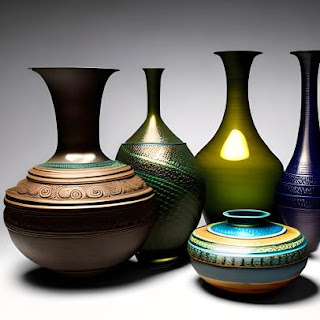The art of glassblowing
The Fascinating Art of Glassblowing: A Creative and Ancient Expression of Human Ingenuity
If you're looking for a unique and captivating art form, look no further than glassblowing. This ancient craft involves shaping molten glass into various forms using a blowpipe and other tools, resulting in beautiful and functional objects that showcase human creativity and skill.
 |
| Glassblowing was invented by Syrian craftsmen in the 1st century BC, where blown vessels for everyday and luxury use were produced commercially and exported to all parts of the Roman Empire. |
A Brief History of Glassblowing
Glassblowing has been around for thousands of years, with its origins traced back to Syrian craftsmen in the 1st century BC. They created blown vessels for everyday and luxury use that were exported to all parts of the Roman Empire. Since then, glassblowing has evolved into a diverse and creative expression of human ingenuity and artistry.
 |
An image of a glassblower shaping molten glass on a marver with tools nearby |
The Process of Glassblowing
Glassblowing is a fascinating and intricate art form that requires patience, precision, and coordination. The process of glassblowing involves several steps, which we'll walk you through in this article.
Step 1: Gathering
The first step in glassblowing is gathering. The glassblower takes a metal tube called a blowpipe and dips it into a furnace filled with molten glass. The end of the blowpipe collects a small amount of molten glass, which the glassblower then shapes into a round blob by rotating the pipe.
Step 2: Shaping
Once the glass is gathered, the glassblower begins shaping it using a variety of tools. The glassblower blows air through the blowpipe to create a bubble in the center of the glass blob. The glass can be shaped further by using tools such as tweezers, shears, and jacks. The glass can also be rolled on a flat surface called a marver to shape it.
Step 3: Coloring
After shaping, the glass can be colored by adding metal oxides or frits to the molten glass. The glass can also be colored by applying them to the surface of the blown glass. The glass can be heated and shaped again to create intricate patterns and designs.
Step 4: Reheating
After the glass is shaped and colored, it must be reheated to maintain its malleability. The glass is reheated in a smaller furnace called a glory hole. The glassblower can add more glass or other materials such as a metal leaf or murrine to the glass during the reheating process.
Step 5: Finishing
Finally, the glass is finished by cooling it slowly to prevent cracking or breaking. The glass can be cut or engraved to create a smooth surface. The finished piece can be further polished by using sandpaper or other abrasive materials.
Glassblowing is an art that requires skill, patience, and creativity. With practice and dedication, anyone can learn the art of glassblowing and create beautiful, unique pieces.
 |
A glassblower applying metal oxides to molten glass. |
The Precision and Coordination Required
Glassblowing requires precision, patience, and coordination, as well as an understanding of the properties and behavior of glass. Glassblowers must work quickly and carefully to avoid cracking or breaking the glass due to thermal shock or stress. They must also control the temperature, shape, and thickness of the glass throughout the process. Glassblowing can be done individually or in teams, depending on the size and complexity of the desired piece.
 |
A glassblower manipulating a piece of blown glass with a glory hole nearby. |
The Endless Possibilities of Glassblowing
Glassblowing is not just limited to functional objects but can also be used for artistic expression. It can be combined with other techniques such as casting, fusing, slumping, or cold working, resulting in unique and visually stunning pieces of art. Glassblowing has been influenced by historical events, technological innovations, artistic movements, social changes, environmental concerns, and personal preferences, making it a constantly evolving art form.
The Enjoyable Hobby for Everyone
Glassblowing is not just for professional artists but also an enjoyable hobby that anyone can learn with proper instruction and practice. With endless possibilities for creating beautiful objects that reflect one's personality and vision, it's no wonder that glassblowing continues to captivate and inspire people from all walks of life.



Comments
Post a Comment
Comments